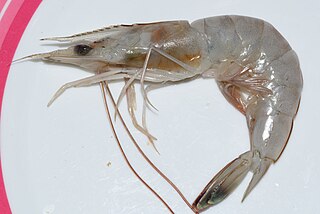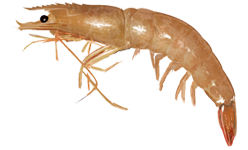Life cycle
Spawning in L. setiferus occurs while the water is warm, between the increase in water temperatures in the spring and the sudden decline in temperature in the fall. [2] It generally occurs within 9 km (5.6 mi) of the shoreline, in water less than 9 metres (30 ft) deep in the Atlantic, or 8–31 metres (26–102 ft) deep in the Gulf of Mexico. [2] Males attach a spermatophore to the females, which is then used to fertilize the eggs as they are released. [2] Each female releases 500,000–1,000,000 purplish eggs, each 0.2–0.3 mm (0.008–0.012 in) across, which sink to the bottom of the water column. [2]
After 10–12 hours, the eggs hatch into nauplius larvae, which are 0.3 mm (0.012 in) long, planktonic and unable to feed. [2] They molt five times to reach the protozoa stage, 1 mm (0.039 in) long. These grow to 2.5 mm (0.098 in) long over two molts, before passing through three molts as a mysis larva. [2] About 15–20 days after hatching, the animals reaches the postlarva stage; in the second postlarval stage, at a length of 7 mm (0.28 in), they begin to enter estuaries and drop down to the substrate. [2]
Spring rains flush the shrimp out into the ocean. In the Eastern United States, shrimp then migrate south towards warmer waters. [5]

Dendrobranchiata is a suborder of decapods, commonly known as prawns. There are 540 extant species in seven families, and a fossil record extending back to the Devonian. They differ from related animals, such as Caridea and Stenopodidea, by the branching form of the gills and by the fact that they do not brood their eggs, but release them directly into the water. They may reach a length of over 330 millimetres (13 in) and a mass of 450 grams (1.0 lb), and are widely fished and farmed for human consumption.

Whiteleg shrimp, also known as Pacific white shrimp or King prawn, is a species of prawn of the eastern Pacific Ocean commonly caught or farmed for food.

The loggerhead sea turtle is a species of oceanic turtle distributed throughout the world. It is a marine reptile, belonging to the family Cheloniidae. The average loggerhead measures around 90 cm (35 in) in carapace length when fully grown. The adult loggerhead sea turtle weighs approximately 135 kg (298 lb), with the largest specimens weighing in at more than 450 kg (1,000 lb). The skin ranges from yellow to brown in color, and the shell is typically reddish brown. No external differences in sex are seen until the turtle becomes an adult, the most obvious difference being the adult males have thicker tails and shorter plastrons than the females.

The shrimp fishery is a major global industry, with more than 3.4 million tons caught per year, chiefly in Asia. Rates of bycatch are unusually high for shrimp fishing, with the capture of sea turtles being especially contentious.

Marine shrimp farming is an aquaculture business for the cultivation of marine shrimp or prawns for human consumption. Although traditional shrimp farming has been carried out in Asia for centuries, large-scale commercial shrimp farming began in the 1970s, and production grew steeply, particularly to match the market demands of the United States, Japan and Western Europe. The total global production of farmed shrimp reached more than 1.6 million tonnes in 2003, representing a value of nearly 9 billion U.S. dollars. About 75% of farmed shrimp is produced in Asia, in particular in China and Thailand. The other 25% is produced mainly in Latin America, where Brazil, Ecuador, and Mexico are the largest producers. The largest exporting nation is India.
White spot syndrome (WSS) is a viral infection of penaeid shrimp. The disease is highly lethal and contagious, killing shrimp quickly. Outbreaks of this disease have wiped out the entire populations of many shrimp farms within a few days, in places throughout the world.
Necrotising hepatopancreatitis (NHP), is also known as Texas necrotizing hepatopancreatitis (TNHP), Texas pond mortality syndrome (TPMS) and Peru necrotizing hepatopancreatitis (PNHP), is a lethal epizootic disease of farmed shrimp. It is not very well researched yet, but generally assumed to be caused by a bacterial infection.

Penaeus is a genus of prawns, including the giant tiger prawn, the most important species of farmed crustacean worldwide.

Penaeus monodon, commonly known as the giant tiger prawn, Asian tiger shrimp, black tiger shrimp, and other names, is a marine crustacean that is widely reared for food.

Panulirus argus, the Caribbean spiny lobster, is a species of spiny lobster that lives on reefs and in mangrove swamps in the western Atlantic Ocean.
Farfantepenaeus notialis is a species of marine crustacean in the family Penaeidae.

Tarpon are fish of the genus Megalops. They are the only members of the family Megalopidae. Of the two species, one is native to the Atlantic, and the other to the Indo-Pacific Oceans.

Sicyonia brevirostris, the brown rock shrimp, is a species of prawn. It is found along the coasts of the western Atlantic Ocean and Gulf of Mexico from Norfolk, Virginia to Yucatán, including Cuba and the Bahamas. It is used in cooking and has a taste and texture similar to lobster. They get their name from their hard outer shell which is "hard as a rock".

A shrimp (pl.: shrimp or shrimps is a crustacean with an elongated body and a primarily swimming mode of locomotion – typically belonging to the Caridea or Dendrobranchiata of the order Decapoda, although some crustaceans outside of this order are also referred to as "shrimp".

Farfantepenaeus aztecus is a species of marine penaeid shrimps found around the east coast of the US and Mexico. They are an important commercial species in the US. The FAO refers to them as the northern brown shrimp; other common names, used in the US, are brown shrimp, golden shrimp, red shrimp or redtail shrimp.

Farfantepenaeus duorarum is a species of marine penaeid shrimp found around Bermuda, along the east coast of the United States and in the Gulf of Mexico. They are a significant commercial species in the United States and Cuba.
Sicyonia ingentis is a species of prawn in the family Sicyoniidae known by the common name ridgeback prawn. It is native to the eastern Pacific Ocean, where it occurs along the coast of California and Baja California, its distribution extending from Monterey Bay to Isla María Madre off Nayarit. It also lives in the Gulf of California. Other common names include Pacific rock shrimp and Japanese shrimp. In Spanish it is called camarón de piedra del Pacífico and cacahuete.
Black gill disease, also known as black spot disease or black death, is a disease affecting various species of marine animals, including shellfish and crustaceans, across the Atlantic and Pacific oceans. The disease is characterized by the visibly noticeable black melanated gills, speculated to be caused by a fungus called Fusarium solani or a similarly shaped ciliate. Human consumption of fish affected by black gill disease is harmless.

Melicertus kerathurus, the striped prawn or caramote prawn is a species of tiger prawn from the family Penaeidae which occurs in the eastern Atlantic and Mediterranean Sea which is an important species in commercial fisheries. It is the type species for the genus Melicertus.

The Rio Grande marine ecoregion covers the waters offshore of the southern Brazilian states of Rio Grande do Sul and Santa Catarina. The ecoregion stretches along 500 miles of sandy beach coast, and 200 miles out to sea. The warm Brazil Current flows south through the region in parallel with the coast. The continental shelf is smooth and flat, with the bottom mostly sand and mud. Overfishing is a problem, but marine life in recent years has benefited from measures such as a 2018 ban on motorized shrimp trawler fishing within 12 miles of the Rio Grande do Sul coast. The Rio Grande ecoregion is one of four coastal marine ecoregions in the Warm Temperate Southwestern Atlantic marine province. It is thus part of the Temperate South America realm. .

















